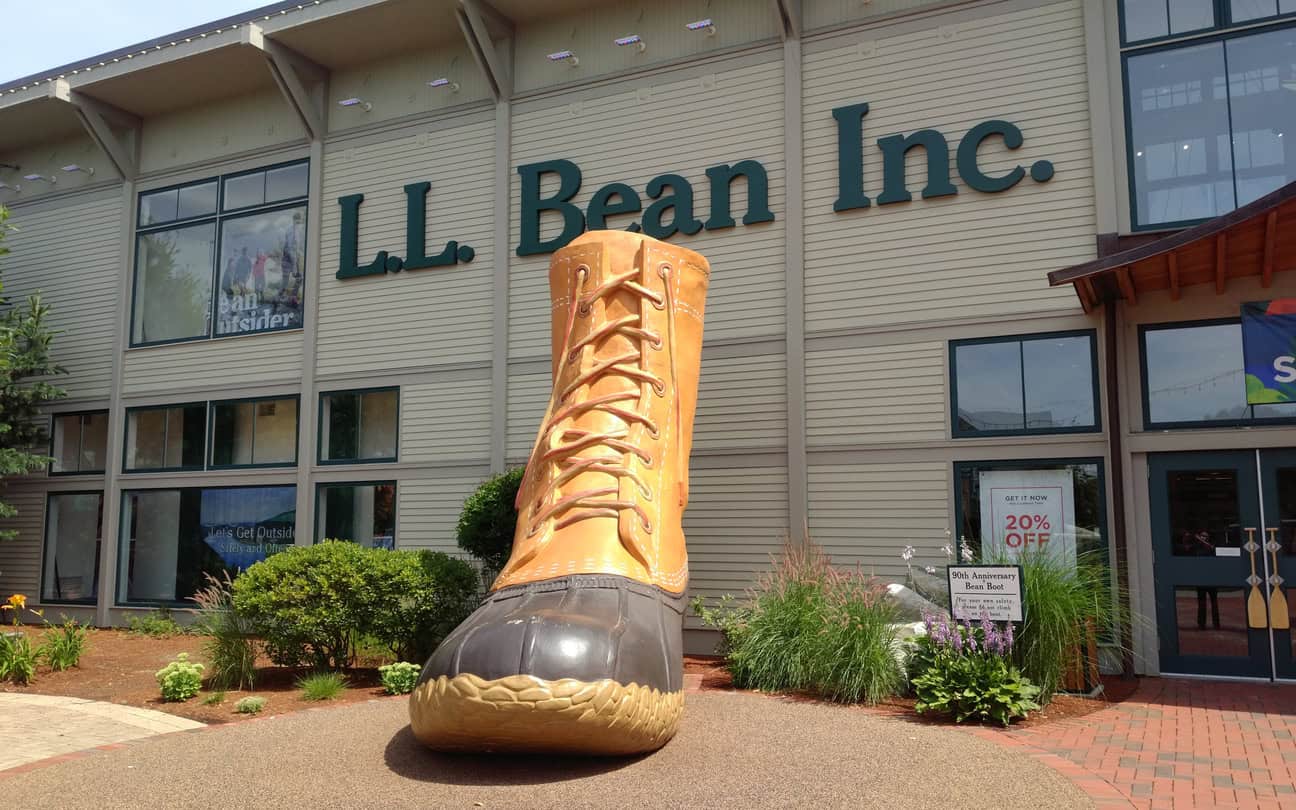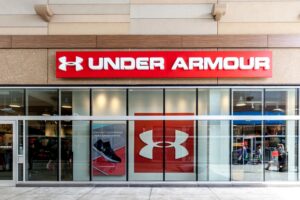
iStock.com/ARK NEYMAN
September 25, 2024
How Critical Are Investments in Retail Flagships?
Earlier this month, L.L.Bean announced the next phase of a major upgrade to its Freeport flagship location, which already ranks as the second-most-visited tourist destination in Maine.
The major developments that are about to get underway include a new first-floor entrance to the store and a grand staircase, a new multitiered trout pond, a larger stream tank that has twice as much swimming space for fish and two viewing bubbles, and a new in-store eatery.
“When my great-grandfather, L.L., opened his first retail space above the Freeport post office in 1917, he never imagined what it would become. But he knew what he wanted it to be. A place that strived to bring customers in, for the purpose of helping them get right back outside,” Shawn Gorman, executive chairman of L.L.Bean, said in a statement. “We’re still committed to that purpose and dreaming bigger than ever before.”
The 220,000-square-foot L.L.Bean retail store campus in Freeport, Maine, welcomes more than 3 million visitors every year.
Among other retailers making recent investments in their flagships, Macy’s in 2021 announced it was committing $235 million to upgrade its Herald Square location. Plans supported a car-free pedestrian space and upgraded subway access outside the location as well as the addition of a tower, roughly 1.5 million square feet, supporting office space above the store.
Opened in 1902, Macy’s Herald Square covers 1.25 million square feet of selling space across 12 floors and attracts more than 20 million shoppers who visit Macy’s Herald Square every year.
In April 2023, Tiffany re-opened its flagship at 57th Street and Fifth Avenue in Manhattan, now called “The Landmark,” following a nearly four-year renovation. Interior updates include white marble interiors, a sculptural spiral staircase, video walls sharing iconic New York scenery, and the 22-foot diamond-shaped skylight illuminating the main floor. Immortalized in the 1961 film “Breakfast at Tiffany’s” starring Audrey Hepburn, the 10-story location opened its doors in 1940.
Anthony Ledru, Tiffany’s president and CEO, said at the time, “The Landmark is much more than a jewelry store — it is a cultural hub with an exquisite showcase of architecture and superior hospitality, as well as cutting-edge art and design. It sets a new bar for luxury retail on a global scale.”
Saks completed a $250 million three-year restoration of its Fifth Avenue flagship in 2019 following its acquisition by HBC in 2013. Over 2018 and 2019, Bloomingdale’s remodeled nearly 200,000 square feet inside its 59th Street flagship, wholly revamping its denim, cosmetics, shoes, and women’s contemporary clothing departments.
Foot Locker, Lululemon, Nordstrom, and American Eagle Outfitters are among other retailers that have flagships in New York City.
In many ways, flagships operated by stores serve the same purpose as those operated by luxury and designer brands operating on Fifth Avenue and Madison Avenue in New York City, as well as pricy spots such as Beverly Hills’ Rodeo Drive or Chicago’s Magnificent Mile. NAIOP (National Association for Industrial and Office Parks) wrote in an article on flagships, “They serve as a showcase for new technology, original artwork, remarkable architecture and dramatic interior design. They often carry exclusive merchandise and offer specialty services. Above all, these stores are an occasion to create a physical embodiment of a brand’s story through design and spectacle.”
However, flagships operated by some brands often lose or make minimal money, as the purpose is to elevate the cachet of a brand. Under Armour’s founder Kevin Plank told Bloomberg in 2014, “I don’t believe in flagship retail, because the definition of flagship retail is that it’s a marketing expense, and it’s going to lose money.”
Discussion Questions
Is it more important for retailers to invest in flagships than regular stores?
What benefits do traditional retailers such as L.L.Bean, Macy’s, or Saks gain from flagships that might be different from flagships supporting designer or luxury brands?
Poll
BrainTrust
Melissa Minkow
Director, Retail Strategy, CI&T
Rachelle King
Retail Industry Thought Leader
Christopher P. Ramey
President, Affluent Insights & The Home Trust International
Recent Discussions







In an ideal world, every store should be treated as a flagship store: every store matters and it is important to invest in the customer and brand experience across the estate.
However, flagships – as in stores that are larger than average or are exceptionally appointed – can play a role depending on the brand in question. For a retailer like LL Bean or Macy’s, their large stores are tourist destinations as much as anything else and the larger footprint is justified by the well-above average foot traffic. For many luxury stores, flagships in expensive locations are marketing statements as much as sales engines.
However, for other retailers, flagships are an expensive bauble. Abercrombie & Fitch used to have flagships in vanity locations, and they proved to be costly distractions that didn’t drive profitable sales or aid brand equity. That’s why the closed them and moved to a more rational model of still larger, but more sensibly sized and configured stores in big cities.
Flagships are really only a solid investment if they’re going to be done extraordinarily well AND if they don’t highlight the fact that other stores are lacking. There needs to be something unique and differentiating about a flagship so that it’s truly a destination and an innovative representation of the brand.
You nailed it!
I do agree with your point and the essence of the article. Flagship stores send signals about the retailers vision and also serve a business purpose. Take the Macy’s in NYC. Despite Macy’s struggles, an argument could be made about the criticality of such an investment given the trendiness of NYC’s retail market and the exposure that comes with 60M domestic and international visitors that experience the Macy’s street display. On the other hand, it is hard for me to rally around significant investment in smaller markets (i.e. Freeport Maine and its 3.5M annual visitors) and products that are less reliant on cutting-edge trends and social status signals (i.e. hiking gear).
Flagships continue to set sail because they accomplish so many goals for brands. Flagship stores are great laboratories for new technologies and customer engagement strategies, they allow brands to boost awareness, control the brand narrative, and deliver stand-out customer experiences that leave lasting impressions. Flagships might not be everyone’s cup of tea, but they’re a smart play for more brands than you might expect.
Uhm Bloomie’s flagship is on Third Ave not Fifth, so perhaps that may be taken as a commentary as to how important such efforts are (or maybe aren’t)
A flagship sets the stage and amplifies the touchpoints that reinforce the brand’s DNA. The investment is worth it if the brand carries it through to other stores. It may not be over-the-top in the regular stores, but it must be.
A flagship one-off is quickly forgotten and lost in the balderdash.
It’s more important for retailers to build and operate productive and profitable stores than to invest in a single flagship. Once the business is stable, a flagship can be evaluated but retailers need to be clear on goals, expectations and potential loss.
While flagship stores can serve as dynamic, creative expressions for brands and offer extraordinary customer experiences, they often cost more money than they make. If a flagship is integral to the next stage of growth for a retailer (without compromise to established business), then perhaps it’s something to consider. But the key question is, how many flagship stores are critical to the next stage of retail growth?
It’s worth noting that most of the world’s famous flagship stores in New York City have been grandfathered into those locations and would very well struggle to set up a new shop today.
The best rule of retail is to give customers a consistent experience that meets or exceeds expectations. Flagships stores are not needed to accomplish this.
Flagship stores are fun. They support the brand and create must-see locations for fans and shoper-tourists and give the retailer a potential location to try new ideas. Bass Pro/Cabelas and REI do a great job of creating destination stores that bring the flagship experience to their customers. But even Bass Pro, for fans of the company, there’s something really special about the Springfield MO store.
However, by no means does having a flagship store make a break retailer’s success. It’s definitely nice to have.
Do retailers build flagships for the ROI (return on investment…real $$$ or perceived brand equity) or the ROE (return on ego)…??? In today’s market, I think a brand needs as many flagships as it can build. And by flagship I don’t mean some huge palace. I mean a right-sized store with the best possible visual presentation standards and story telling. Stores that maximize differentiation and distinction. Stores that build and reinforce the Brand Promise. Not just another box in another mall with another couple of mannequins in the window.
Even smaller Apple Stores still have the energy and drama that the big ones like Union Square convey. And they often bring more energy and traffic to a shopping center than a traditional department store anchor.
An investment in a flagship today, may not be critical. In today’s world, with national retail, and e-commerce, I am afraid the flagship has lost some importance to the average customer. Certainly in destinations such as NYC or Miami, a flagship can and does have impact and should be treated as an exemplar of whatever company it is supposed to represent. In locations such as that, a flagship should be considered to be undertaken by a company and should have everything possible in their assortment, along with fun and excitement to drive desire for future engagement with the brand. Thus the prevalence of flagships in NYC, Duh. In other places however, I guess it depends on the company. I personally never plan on a visit to the flagship for L L Bean. Nothing against L L Bean and I like their offerings, and I own L L Bean product however, I just have no forseeable plans of visiting Maine. I Really like VonMaur, however, again, I have no plans in the foreseeable future of a visit to Davenport Iowa. The VonMaur flagship is probably important to the residents of Davenport IA, as the old time flagship stores of America’s department stores used to be. Of course, large national companies, such as GAP or NIKE can and do have flagship locations in major destinations, however, those stores should NOT simply be large outlets of that company. A “Flagship” store should be an “event” to create desire, want, respect, and appreciation of the company and what it can accomplish.I personally feel that flagship stores should be “Retail as Show” to create a feeling of “WOW”. That is diificult but not impossible and if someone is unclear as to what that means, a study of most large major city former department store flagships, say of 1924, would go a long way to identify, with understanding and allowance for cultural evolution and societal changes, what that means.
I remember at some point the Nike store on Chicago’s miracle mile was the #1 tourist attraction in a city of several world class museums and many professional sports teams. 3 million visitors to LL Bean Freeport annually…yes, investing in these flagship stores is extremely important and brands should continue to invest.
One item that is probably obvious is this investment depends on the brand. WalMart for example does not need a flagship store, the local WalMart museum is fine. Kroger? Nope. Tiffany, Nike, Macy’s etc.-yes of course. But not everyone has a need to make this type of investment.
A flagship store can help define the brand. These are the stores that tell the story and create the brand’s image. The regular stores must also reflect enough of the image of the flagship, or they risk sending mixed or inconsistent messaging to the marketplace.
Flagship stores can be useful if the strategy behind them is tight: test new technology, build excitement, attract new customers. Sadly, most fail and are – as another commenter mentioned – vanity projects where “strategic investment” is code for wasting lots of money. Many have huge rent, average traffic, gadgets that are poorly maintained, and few insights that get leveraged across the broader set of stores. Most companies would be better served developing a viable model for their top, say, 15-20% of stores, testing the heck out of it, and making sure the economics are sound…avoiding hiding behind the “strategic” excuse for losing money.
Retailers like L.L.Bean, Macy’s, and Saks benefit from flagships differently than luxury brands. For them, flagships are about creating an experience that connects deeply with customers, showcasing their heritage, and building loyalty.
This reminds people why they love the brand in the first place. For luxury brands on the other hand, flagships serve more as status symbols and brands often focus on high-end designs that reflects exclusivity.
Regular stores drive revenue, but flagships build lasting emotional connections. That’s why both investments are important, depending on the retailer’s goals.